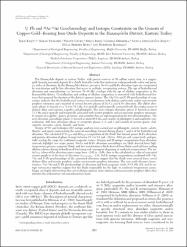U-Pb and Ar-40-Ar-39 Geochronology and Isotopic Constraints on the Genesis of Copper-Gold-Bearing Iron Oxide Deposits in the Hasancelebi District, Eastern Turkey

View/
Date
2011Author
Kuşçu, İlkayYılmazer, Erkan
Güleç, Nilgün
Bayır, Selda
Demirela, Gökhan
Gençalioğlu Kuşcu, Gonca
Kaymakcı, Nuretdin
Metadata
Show full item recordAbstract
The Hasancelebi deposit in eastern Turkey, with proven reserves of 95 million metric tons, is a copper-gold-bearing iron oxide deposit. It is chiefly hosted by rocks that underwent widespread sodic-calcic and potassic styles of alteration. In the Hasancelebi district, pervasive Na-Ca and K-Fe alteration types are overprinted by sericitization and by late alteration that occur in multiple, overprinting systems. The age of hydrothermal alteration and mineralization (ca. between 74-68 Ma) overlaps with the age of alkaline magmatism in the Hasancelebi district. Crystallization and cooling of alkaline magmatism is associated with hydrothermal features that spanned the duration of the district's igneous history. The Ar-40/Ar-39 and U-Pb geochronology of magmatism indicate that the hydrothermal system was synchronous with diabase and syenite and/or microsyenite porphyry intrusions and consisted of several discrete phases of Na-Ca and K-Fe alteration. The oldest alteration (phase 1) formed at ca 74.4 to 74.3 Ma; it is spatially and temporally associated with the emplacement of diabase dikes and contains scapolite and phlogopite. The next younger alteration (phase 2) formed at about 71.3 Ma and is spatially and temporally associated with syenite porphyry and microsyenite porphyry intrusions. It consists of scapolite, garnet, pyroxene, and actinolite that are superimposed on the first alteration phase. The next alteration assemblage (phase 3) formed at about 68.6 Ma and consists of phlogopite 2 and magnetite mineralization. Still later alteration (phase 4) overprints phases 1, 2, and 3 and consists of sericite-quartz, char copyrite, hematite, calcite, fluorite, and barite. Oxygen (delta O-18) and hydrogen (delta D) isotope analyses were carried out on phlogopite, sericite, barite, calcite, fluorite, and quartz representing the mineral assemblage formed during phases 1 and 4 of the hydrothermal alteration. The calculated delta O-18((H2O)) and delta D-(H2O) composition of the fluids that formed preore K-Fe alteration and postore alteration of phase 4 range between 15.1 to 8.5 and -124 to -85.6 per mil, respectively, and partially overlap the range for traditional magmatic waters. Oxygen and H isotope compositions from alteration minerals highlight two major points: Na-Ca and K-Fe alteration assemblages are likely derived from high-temperature primary magmatic fluids, and late sericitization is likely derived from fluids exsolved from cooling alkaline plutons during hydrothermal fracturing and consequent degassing at moderate temperatures. The initial epsilon(Ndi) values of the alteration zones range from -2.02 to -2.08, close to the calculated epsilon(Nd) value of associated syenite porphyry at the time of alteration (epsilon(Nd) ((6s.64Ma); -1.9). Nd-Sr isotope compositions combined with Ar-40-Ar-39 and U-Pb geochronology of the associated alteration suggest that the fluids were sourced from coeval diabase dikes and syenite porphyry and/or microsyenite porphyry intrusions. The rare earth element characteristics, Ar-40-Ar-39 and U-Pb geochronology of alteration and fresh magmatic rocks, delta O-18, delta D, Nd, and Sr isotope systematics together suggest that the fluids responsible for the high- to moderate-temperature assemblages are largely derived from the coeval alkaline igneous rocks (diabase and microsyenite porphyry dikes) that intrudes the sedimentary-volcanosedimentary basin.

















